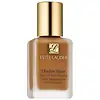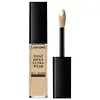Estée Lauder Double Wear Stay-in-Place Foundation Versus Lancôme Teint Idôle Ultra Wear All Over Concealer
What's inside
What's inside
 Key Ingredients
Key Ingredients

 Benefits
Benefits

 Concerns
Concerns

 Ingredients Side-by-side
Ingredients Side-by-side

Water
Skin ConditioningCyclopentasiloxane
EmollientTrimethylsiloxysilicate
EmollientPEG/PPG-18/18 Dimethicone
EmulsifyingButylene Glycol
HumectantTribehenin
EmollientPolyglyceryl-3 Diisostearate
EmulsifyingMagnesium Sulfate
Tocopheryl Acetate
AntioxidantPolymethylsilsesquioxane
Methicone
EmollientLaureth-7
EmulsifyingXanthan Gum
EmulsifyingAlumina
AbrasiveSodium Dehydroacetate
PreservativeDisteardimonium Hectorite
StabilisingCellulose Gum
Emulsion StabilisingPropylene Carbonate
SolventPentaerythrityl Tetra-Di-T-Butyl Hydroxyhydrocinnamate
AntioxidantPhenoxyethanol
PreservativeIron Oxides
Mica
Cosmetic ColorantCI 77891
Cosmetic ColorantWater, Cyclopentasiloxane, Trimethylsiloxysilicate, PEG/PPG-18/18 Dimethicone, Butylene Glycol, Tribehenin, Polyglyceryl-3 Diisostearate, Magnesium Sulfate, Tocopheryl Acetate, Polymethylsilsesquioxane, Methicone, Laureth-7, Xanthan Gum, Alumina, Sodium Dehydroacetate, Disteardimonium Hectorite, Cellulose Gum, Propylene Carbonate, Pentaerythrityl Tetra-Di-T-Butyl Hydroxyhydrocinnamate, Phenoxyethanol, Iron Oxides, Mica, CI 77891
Water
Skin ConditioningUndecane
EmollientDimethicone
EmollientGlycerin
HumectantTridecane
PerfumingPolyglyceryl-4 Isostearate
EmulsifyingPentylene Glycol
Skin ConditioningCetyl PEG/PPG-10/1 Dimethicone
EmulsifyingHexyl Laurate
EmollientMagnesium Sulfate
Disteardimonium Hectorite
StabilisingRosa Gallica Flower Extract
AstringentHelianthus Annuus Seed Oil
EmollientMoringa Oleifera Seed Extract
Skin ConditioningNymphaea Alba Flower Extract
Skin ConditioningIsobutane
Sorbitol
HumectantTrihydroxystearin
Skin ConditioningCellulose Gum
Emulsion StabilisingAluminum Hydroxide
EmollientDisodium Phosphate
BufferingDisodium Stearoyl Glutamate
CleansingPropanediol
SolventPropylene Glycol
HumectantCitric Acid
BufferingAcetylated Glycol Stearate
EmollientEthylhexylglycerin
Skin ConditioningAcrylonitrile/Methyl Methacrylate/Vinylidene Chloride Copolymer
Tocopherol
AntioxidantPentaerythrityl Tetra-Di-T-Butyl Hydroxyhydrocinnamate
AntioxidantPhenoxyethanol
PreservativeWater, Undecane, Dimethicone, Glycerin, Tridecane, Polyglyceryl-4 Isostearate, Pentylene Glycol, Cetyl PEG/PPG-10/1 Dimethicone, Hexyl Laurate, Magnesium Sulfate, Disteardimonium Hectorite, Rosa Gallica Flower Extract, Helianthus Annuus Seed Oil, Moringa Oleifera Seed Extract, Nymphaea Alba Flower Extract, Isobutane, Sorbitol, Trihydroxystearin, Cellulose Gum, Aluminum Hydroxide, Disodium Phosphate, Disodium Stearoyl Glutamate, Propanediol, Propylene Glycol, Citric Acid, Acetylated Glycol Stearate, Ethylhexylglycerin, Acrylonitrile/Methyl Methacrylate/Vinylidene Chloride Copolymer, Tocopherol, Pentaerythrityl Tetra-Di-T-Butyl Hydroxyhydrocinnamate, Phenoxyethanol
 Reviews
Reviews

Ingredients Explained
These ingredients are found in both products.
Ingredients higher up in an ingredient list are typically present in a larger amount.
Cellulose Gum is a water-soluble polymer that comes from cellulose. It is used to change the texture of a product and to help stabilize emulsions.
As an emulsifier, cellulose gum specifically thicken the texture of water-based products.
This ingredient is considered hypoallergenic and non-toxic. Cellulose Gum can be found in cosmetics, food, and other household goods such as paper products.
Learn more about Cellulose GumDisteardimonium Hectorite comes from the clay mineral named hectorite. It is used to add thickness to a product.
It can also help stabilize a product by helping to disperse other ingredients.
Hectorite is a rare, white clay mineral.
Learn more about Disteardimonium HectoriteMagnesium Sulfate is a salt. More specifically, it is an epsom salt, or the bath salt used to help relieve muscle aches.
Despite having ‘sulfate’ in the name, it isn’t a surfactant or cleansing agent like sodium lauryl sulfate. Unlike those sulfates, magnesium sulfate doesn’t have the same cleansing or foaming properties (it's simply a type of salt).
In cosmetics, Magnesium Sulfate is used to thicken a product or help dilute other solids. It is a non-reactive and non-irritating ingredient.
One study shows magnesium deficiency may lead to inflammation of the skin. Applying magnesium topically may help reduce inflammation.
You can find this ingredient in sea water or mineral deposits.
Learn more about Magnesium SulfatePentaerythrityl Tetra-Di-T-Butyl Hydroxyhydrocinnamate (long name, huh?) is a synthetic antioxidant.
It is used to help stabilize other antioxidants or prevent the color from changing in a product.
As an antioxidant, it helps fight free-radical molecules. Free-radical molecules are capable of damaging our cells and other genetic material. Thus, antioxidants may reduce the signs of aging.
This ingredient is oil-soluble.
Learn more about Pentaerythrityl Tetra-Di-T-Butyl HydroxyhydrocinnamatePhenoxyethanol is a preservative that has germicide, antimicrobial, and aromatic properties. Studies show that phenoxyethanol can prevent microbial growth. By itself, it has a scent that is similar to that of a rose.
It's often used in formulations along with Caprylyl Glycol to preserve the shelf life of products.
Water. It's the most common cosmetic ingredient of all. You'll usually see it at the top of ingredient lists, meaning that it makes up the largest part of the product.
So why is it so popular? Water most often acts as a solvent - this means that it helps dissolve other ingredients into the formulation.
You'll also recognize water as that liquid we all need to stay alive. If you see this, drink a glass of water. Stay hydrated!
Learn more about Water